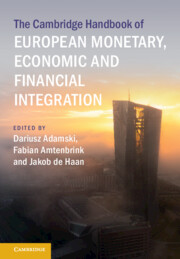Book contents
- The Cambridge Handbook of European Monetary, Economic and Financial Integration
- The Cambridge Handbook of European Monetary, Economic and Financial Integration
- Copyright page
- Contents
- Contributors
- Introduction
- Part I The Economic and Monetary Union
- Part II The Monetary Dimension
- Part III The Economic and Fiscal Dimensions
- 15 Reviving the Case for Policy Coordination in EMU
- 16 Ten Years of the European Semester
- 17 The EU Fiscal Rules
- 18 National Fiscal Policy in EMU
- 19 The Politics of Fiscal Integration in Eurozone Reforms and Next Generation EU
- 20 Adjustments in Economic Crises
- 21 Designing a Permanent EU-Wide Stabilization Facility
- 22 Enhancing Private and Public Risk Sharing
- Part IV Financial Integration
- Index
- References
17 - The EU Fiscal Rules
Principle, Policy, and Reform Prospects
from Part III - The Economic and Fiscal Dimensions
Published online by Cambridge University Press: 28 September 2023
- The Cambridge Handbook of European Monetary, Economic and Financial Integration
- The Cambridge Handbook of European Monetary, Economic and Financial Integration
- Copyright page
- Contents
- Contributors
- Introduction
- Part I The Economic and Monetary Union
- Part II The Monetary Dimension
- Part III The Economic and Fiscal Dimensions
- 15 Reviving the Case for Policy Coordination in EMU
- 16 Ten Years of the European Semester
- 17 The EU Fiscal Rules
- 18 National Fiscal Policy in EMU
- 19 The Politics of Fiscal Integration in Eurozone Reforms and Next Generation EU
- 20 Adjustments in Economic Crises
- 21 Designing a Permanent EU-Wide Stabilization Facility
- 22 Enhancing Private and Public Risk Sharing
- Part IV Financial Integration
- Index
- References
Summary
The future direction of the Economic and Monetary Union (EMU) has been the subject of heated debate. Among those features pertaining to the reform of EMU, this chapter focuses on the EU fiscal rules. The discussion begins with an overview of the existing EU framework for fiscal and economic governance, its economic rationale, and the reforms adopted in response to the eurozone crisis. This is followed by analysis of the preventive and corrective arms of the Stability and Growth Pact, on which this contribution principally focuses. We then turn to consider the criticism to which the existing EU framework for fiscal coordination and surveillance has been subjected. The focus then shifts to the various proposals on the future evolution of the EU’s fiscal and economic governance framework. The penultimate section provides a legal assessment of the proposed reforms, thereby setting out what would be required, from a legal perspective, in order to amend, replace, or repeal the various aspects of the existing framework. The final section argues that the (potential) reform of the EU fiscal rules is but a key piece of the broader puzzle of EMU reform, and that therefore we should not neglect its other aspects.
- Type
- Chapter
- Information
- Publisher: Cambridge University PressPrint publication year: 2023



